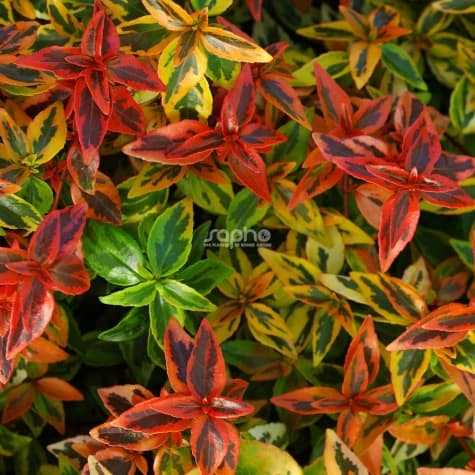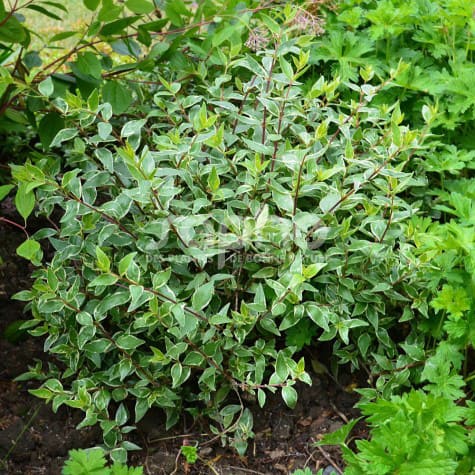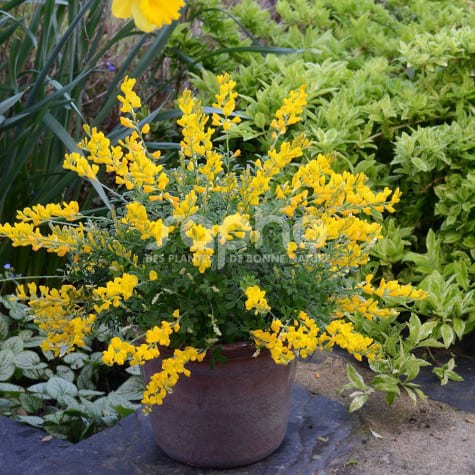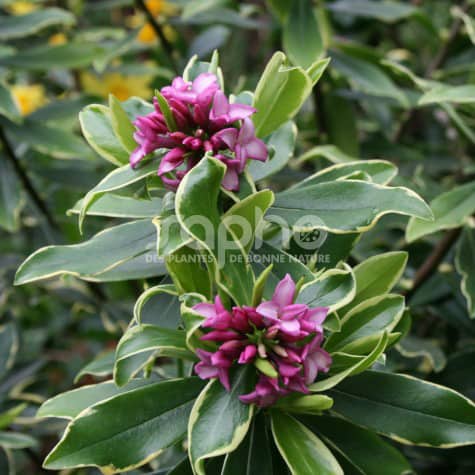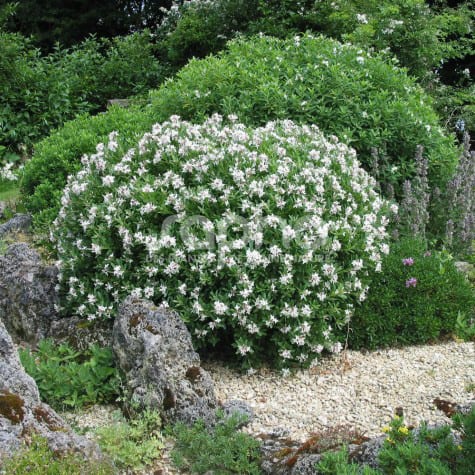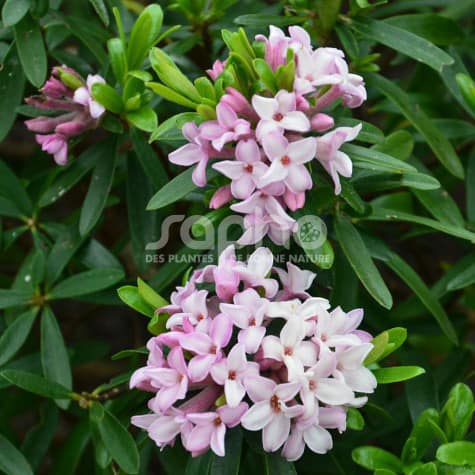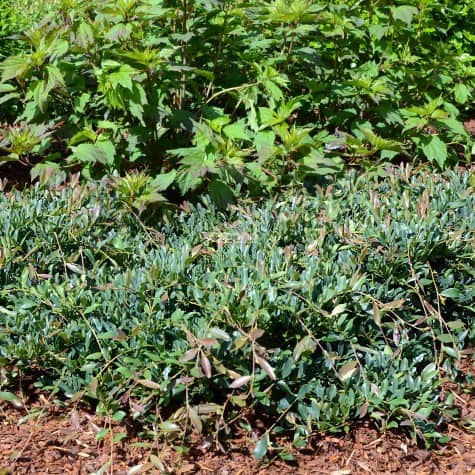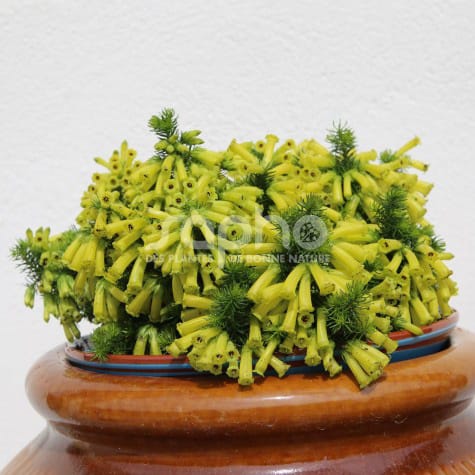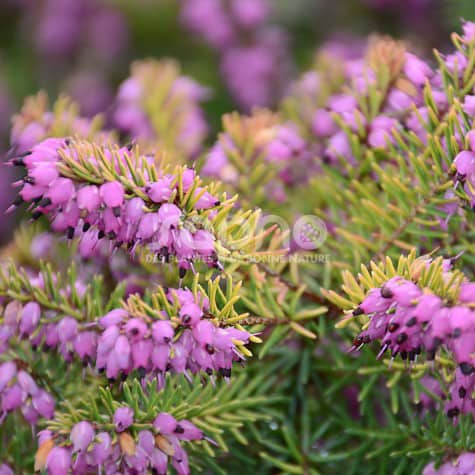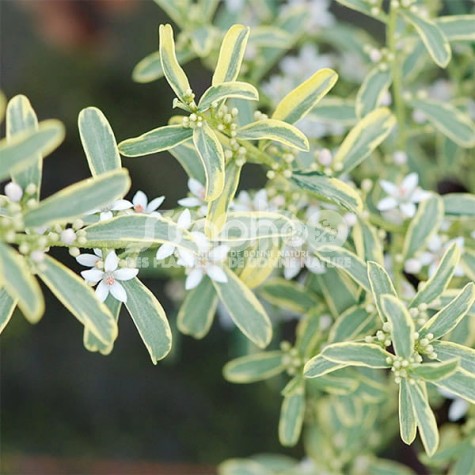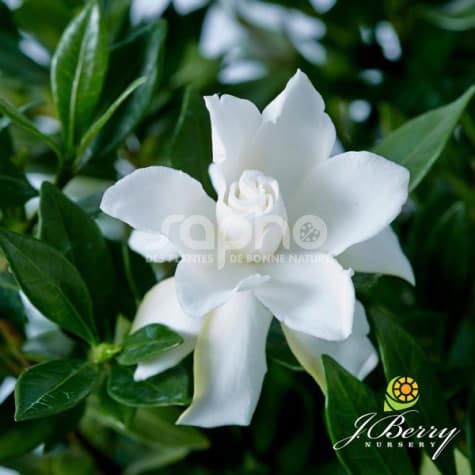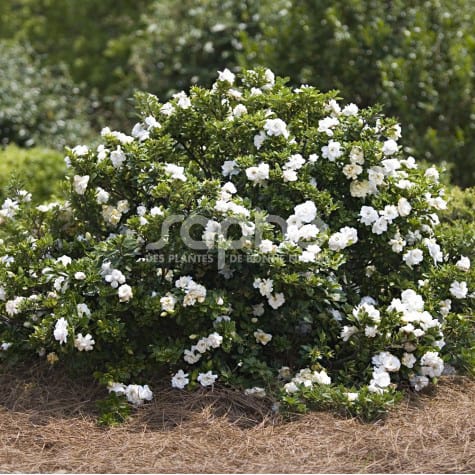A constantly renewed kaleidoscope, much appreciated by gardeners.
This evergreen shrub with variegated foliage, light green and golden yellow in spring, is coming into young orange coloured shoots turning to scarlet red at the end of summer up to winter. These shades can vary according to the position, climate and type of soil.Its growth is dense and even.The lightly fragrant white flowers, from June to September-October, stand in beautiful contrast to the purple stems.Must be protected in regions with cold winters.
Trophies:
Bronze Medal at PLANTARIUM 2006 (Boskoop - NETHERLANDS)
Filter By
Foliage
Position
Categories
Menu
All our varieties
A little abelia with white rimmed leaves.Of vigourous growth for this type of variegated plant, the shrub is very well-branched. The foliage is bright and the variegation stable.The white flowers last from June - July to October.LUCKY LOTS is suitable as small shrub in beds, in association with perennials for example, and in pots, decorates balconies and terraces.
Just like a sun! Must be potgrown and protected during cold winters.This INRAE - EUROGENI variety has been selected for its regular growth, more compact and branched than the standard species, even without trimming. For production in nurserys no regulators are needed.Beautiful healthy dark green foliage and fine wood. The abundant scented flowering in March-April is 8 - 10 days later than the Cytisus Racemosus and of a more orangey yellow.A real sun in spring, PHEBUS® must be potgrown and protected during cold winters.Trophies: Bronze Medal at Innovert® 2016 Horticulture category (Angers - FRANCE)
An evergreen and brightly variegated foliage, highly fragrant flowers, and great branching as a bonus!Resulting from a natural mutation, Daphne odora 'Rogalski' is more compact, more branched, and with smaller leaves than the original variety, Daphne odora 'Aureomarginata'. 'Rogalski' is particularly suitable for small gardens. It is also easier to grow because it branches very well from the start. Its shorter branches are stronger at the time of flowering. Daphne 'Rogalski' retains all the superb qualities of the original variety: a beautiful evergreen foliage, bright green with yellow edges, and flowers with an intense fragrance. Among the range of small evergreen shrubs available for the garden, it is one of the first to flower. (February - March). It brings interest with its intense fragrance and lights up the dark corners to the garden with its foliage.
Nearly everlasting, very fragrant flowers…
The flowers of these new Daphne ETERNAL FRAGRANCE and PINK FRAGRANCE cultivations are intensely fragrant and almost "everlasting" : abundant for 4 to 6 weeks at the end of spring (from end of June tod August), then flowering again on this years shoots, all through the summer until end of October (5 to 6 months in total).ETERNAL FRAGRANCE offers a mass of light pink flower buds, white flowers at the wilting stage pink with yellow-orange anthers. The foliage is average, evergreen to semi-evergreen.The shape is tight and round.PINK and ETERNAL FRAGRANCE, thanks to their compact shape and powerful fragrance, find a place, particularly in the open or in pots next to a habitation: the entrance to a house, the terrace, or retreat... They flower best in full sun, but tolerate half shade.
Trophies:
1st prize at INNOVERT® 2013 Nursery Category (ANGERS, FRANCE)
Fragrant flowers all summer long.The flowers of these new Daphne ETERNAL FRAGRANCE and PINK FRAGRANCE selections are intensely perfumed and almost "everlasting": abundant for 4 to 6 weeks at the end of spring (between end of June and August), then flowering again on this years shoots, all through the summer until end of October (5 to 6 months in total).At the beginning of the season, PINK FRAGRANCE is covered in violet pink flowers, with yellow-orange anthers; the summer and autumn flowers are light pink to white.The foliage is average, evergreen to semi-evergreen.The shape is dense and round.PINK and ETERNAL FRAGRANCE, thanks to their compact shape and powerful fragrance, find their place, particularly in the open or in pots next to a habitation: the entrance to a house, the terrace, or retreat... They flower best in full sun, but tolerate half shade.
A novelty amongst the small evergreen shrubsThis selection by M. DIRR is a hybrid between Distylium myricoides and Distylium racemosus.Resistant to insects and pathogenic agents, tolerating drought and heat, BLUE CASCADE® is an excellent replacement for traditional evergreen shrubs. Bronze during budding, the long and straight foliage then turns original mat blue-green.The flowering is insignificant.Its dense and compact cascading growth, allows it to be used in low hedges or as ground cover, in regions with temperate winters (hardy down to -15°C). It is also happy grown in pots.Avoid too basic ph soil.
A highly unusual heather for mild climatesA heather with a difference, amazing colour and unusual habit! In spring, Erica nana Limoncello® blooms with a beautiful profusion of bright lemon yellow flowers, contrasting against the dark green foliage. The flowers are large, ca. 2 cm long and tubular in shape. Selected as a seedling of Erica nana, this new variety, Limoncello®, is distinguished from the type species by its naturally upright habit. It is a small, slow-growing shrub that is easy to shape in pots. Limoncello® is best suited to mild climates and coastal areas.
A precious heather for the garden.
Mutant of the well-known variety 'Kramer's Rote', 'Eva Gold' possesses all its qualities: rapid growth, rounded and compact shape, long-lasting and abundant red flowers in the middle of winter for an Erica type heather.
The colour of its foliage has the particularity of changing throughout the year, from the light green new growth, turning golden yellow in summer, again becoming pure green in winter.
Attractive individually or in large groups, possibly planted with other heathers, 'Eva Gold' will embellish borders and slopes, as much with its remarkable flowers from November to March, as with its bright yellow colour in summer, which does not fade in the sun. It can also be planted in pots.
Trophies:
Praised by the Boskoop observation station (NETHERLANDS)
The elegance of the Eriostemon, the variegation in addition !
This variety of eriostemon is distinguished by its elegant, bright, variegated evergreen foliage. It blooms with a myriad of small, starry, fragrant flowers.
Its silhouette is both dense and light, with supple branches and fine leaves. Interesting as a natural or pruned plant.
A small shrub that performs well in pots, it can also be planted in the ground in mild climates.
nb : award merit at the Journées des Plantes de Chantilly, France Automne 2022 and Bronze Medal at the Concours Nouveautés Plantarium 2022
Doubled and perfumed, the elegance of a gardenia in the gardenGardenia Celestial Star® is a shrub producing elegant white flowers with a remarkable perfume that are doubled and scrolled at the heart. The first flowers emerge at the end of spring - beginning of summer. The display is sustained throughout the summer months with a generous production of flowers once the plant is well settled in. Gardenia Celestial Star® has a beautifully varnished and persistent foliage. Its excellent growth, ready branching, easy cultivation and relative resistance to frost allow its use as a garden Gardenia or as a terrace plant.
A hardy gardenia with very fragrant double flowers.
Native to South Carolina, 'Crown Jewel' is a selection of Gardenia with a frost tolerance of -10° C, or even lower depending on planting conditions.
In June-July, this shrub produces very attractive double blooms giving off a powerful perfume.
Its flowers are more abundant compared with those of the parent plants, especially 'Kleim's Hardy', and sometimes come out later. Some flowers still bloom at the end of summer.
The medium-sized white flowers which can reach 6-7 cm in diameter offer a good contrast to the attractive glossy dark green leaves, smaller than in other varieties. This one stays evergreen in winter.
The shrub has a dwarf, spreading growth, compact and well-branched. It is a low grower.
'Crown Jewel' can therefore be used outside most of the time, in beds, in pots, near the house, on a terrace, a balcony, where the double flowers with their fine scent will be especially appreciated in summer.

